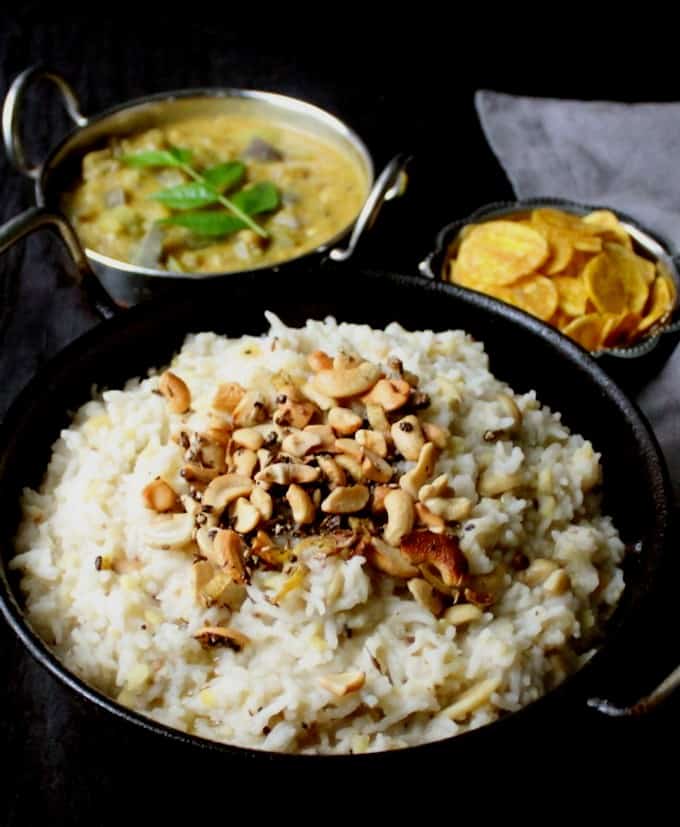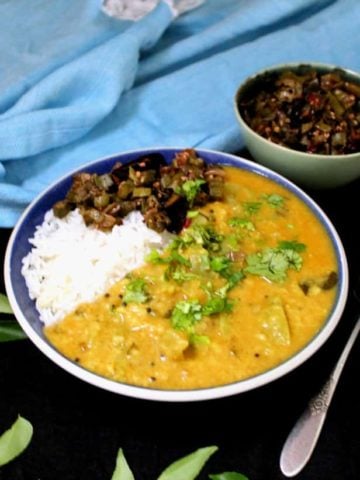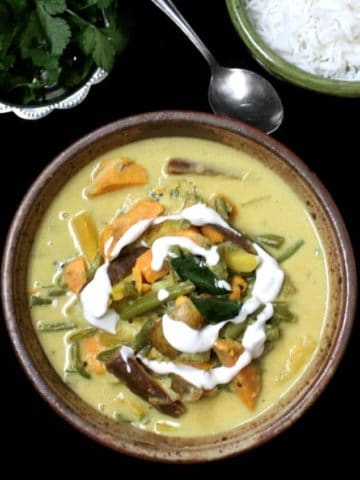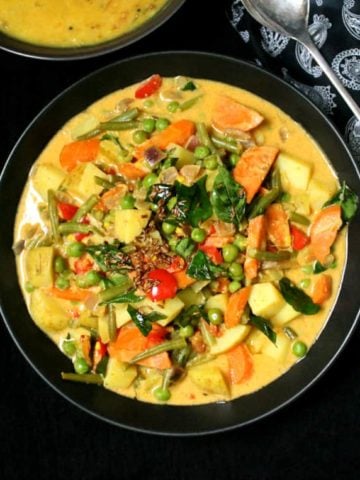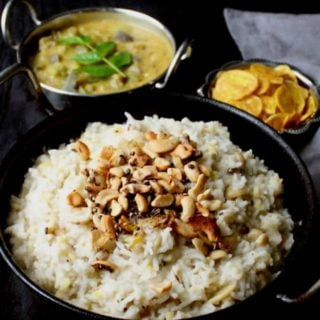January is the month when Tamilians celebrate Pongal, the harvest festival. This is a four-day affair and it involves lots of good eats, including two namesake dishes made with the newly harvested rice and lentils, one sweet and the other savory. The sweet pongal, with jaggery added to it, is called sakkarai pongal or chakkara pongal. The savory kind, the one I have for you today, is called ven pongal (also “khara pongal” or spicy pongal, although the adjective is used simply to distinguish it from sweet pongal–khara pongal is actually not spicy at all). Ven pongal can be classified as a “khichdi,” – a genre of Indian dishes made by cooking a grain and a legume together. It’s a simple but nourishing formula, easily digested, and a one-dish meal, which makes it perfect for every occasion, from a celebration to illness. I’ve already shared with you many delicious khichdi recipes, from masala khichdi to Instant Pot mung sprouts khichdi to jowar khichdi and sabudana khichdi. Ven Pongal, like all these other khichdis, is the ultimate comfort food. It is food you can eat year-round, for breakfast, for lunch, for dinner, or for a snack – “tiffin,” as Tamilians would call it. It’s easy to make and easy to digest. And it tastes amazing. All you need to make it, besides the rice and lentils, are a handful of ingredients, including cumin seeds, peppercorns, ginger and cashew nuts. The spices offer not just flavor but also warmth to the body during the winter months (although the joke goes that Tamil Nadu is hot in the winter months and hotter in summer). One more key ingredient in Pongal is ghee. Oodles of it, because the ghee here is not just the medium for the tempering, it’s also an important flavor agent. So you can imagine just how much of a challenge it was to veganize pongal, especially since the primary beneficiary of my cooking – or, as he might frame it, the one who has to put up with my incessant experimenting in the kitchen – is my Tamil husband, Desi. Desi loves pongal, he grew up eating it, and I knew that my vegan pongal would have to be as good as the one with ghee, or else he was just not going to love it. The answer I came up with years ago was a simple but effective one: coconut. Coconut oil and coconut milk are staples in Tamil cooking, and although they are not traditional ingredients in a pongal, they make it taste as good as the stuff with ghee in it. Minus the animal cruelty. I’ve been making my vegan pongal for years now, and it’s been on this blog for a while, but bringing it back to the front for those of you who are newer readers, and also because it’s almost Pongal. Try it and come back to tell me if you liked it. It takes 30 minutes from start to finish, if you have a pressure cooker or an Instant Pot, and even if you’re not Tamil or festive, it still makes the perfect – and healthy – weekend or weeknight meal for anyone with an appreciation of good food. Check to get new recipe updates by email.
Expert tips
Ven pongal is usually made with newly harvested, short grain rice, which tends to turn mushy when cooked and doesn’t hold its shape. This might appear to go contrary to other Indian rice dishes like biryani where we focus on getting the rice grains to stay separate, but remember, pongal is a different animal. A good pongal has the consistency of a risotto, and a rice-pudding-like texture. That said, I know that those of us with kitchens outside India do not have five different varieties of rice in our kitchens – at least I don’t. So I just use basmati, and I actually think that works very well because the aroma of basmati enhances the pongal. I do cook the rice with the lentils until it’s really, really soft, to get the right texture. If you do have a short grain Indian rice, like sona masoori, use that instead. You will need yellow mung lentils for pongal. Not the kind with the skin still on, or the whole mung bean – you will need the tiny yellow lentil, sold as moong dal, in Indian groceries or online. There are no compromises or substitutes for this. Different cooks use different ratios of rice to lentils for their pongal, but I like a ration of 2:1 – two parts rice to one part lentils. I find that it gives me the best-tasting pongal. I pressure cook the rice and lentils together – for four whistles. You can use an instant pot – mix the rice and lentils with six cups water and set to pressure cook for 10 minutes. You will need to add the tempering ingredients after the rice and lentils are cooked and mix. You can also do this in a saucepan on the stovetop – cover the rice and lentils with two inches of water, bring to a boil, cover and cook until the rice and lentils are really soft. You will need to keep stirring and adding more water to make sure nothing is sticking to the bottom of the pot. Once the rice and lentils are cooked, you still need to make sure the consistency of the pongal is right. Remember, you need a slightly runny consistency, like that of risotto. Once you have that right, you can stir in your tempering.
Serving suggestions
Desi grew up eating ven pongal with gotsu, a dal also made with moong lentils and veggies. You can also serve it with Avial, a south Indian vegetable curry, or with Sambar, a south Indian dal. Ven Pongal also tastes good, as any khichdi would, with coconut chutney. Serve some Indian lime pickle and poppadum on the side. Serve with this easy potato curry.
More South Indian recipes
Recipe card



